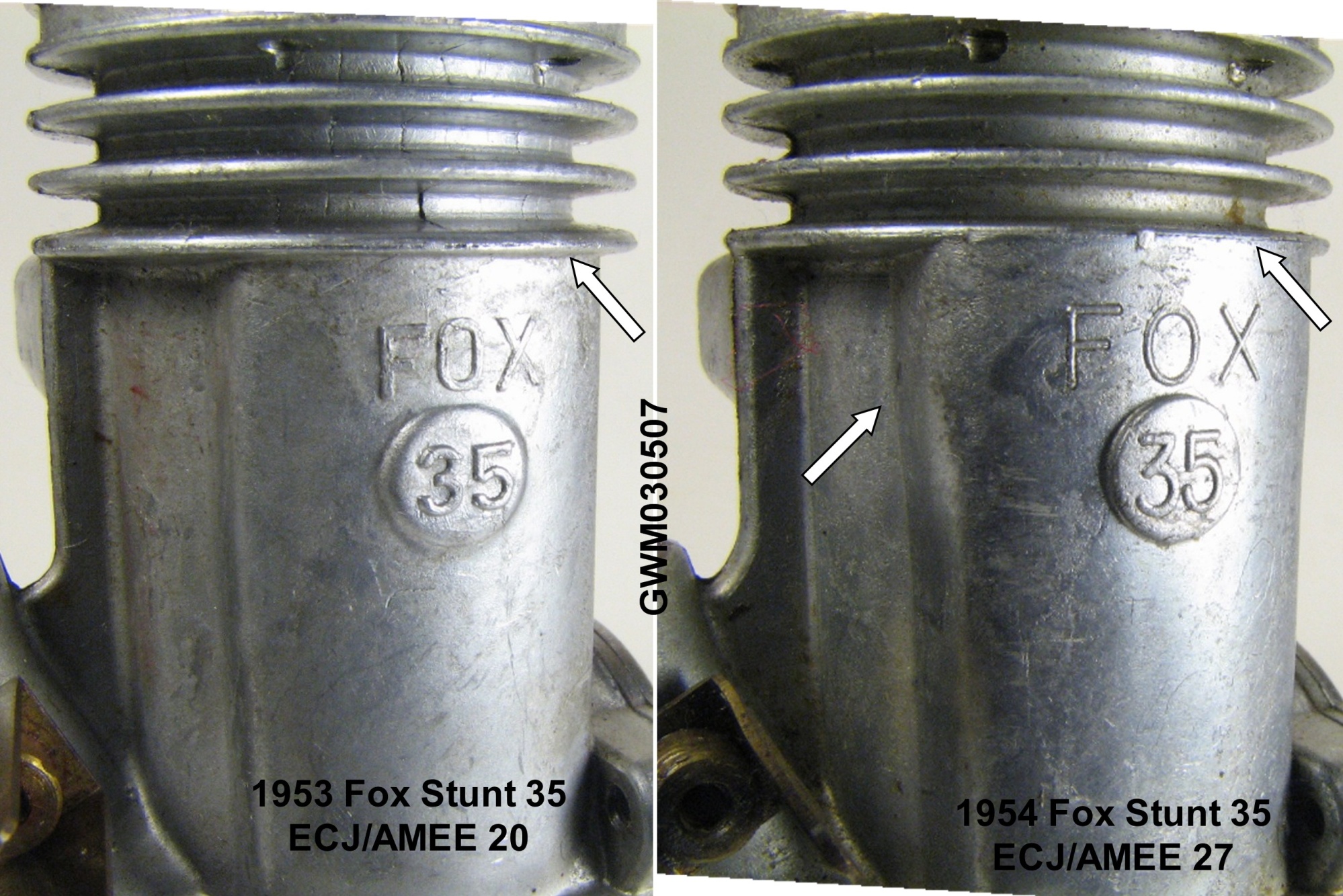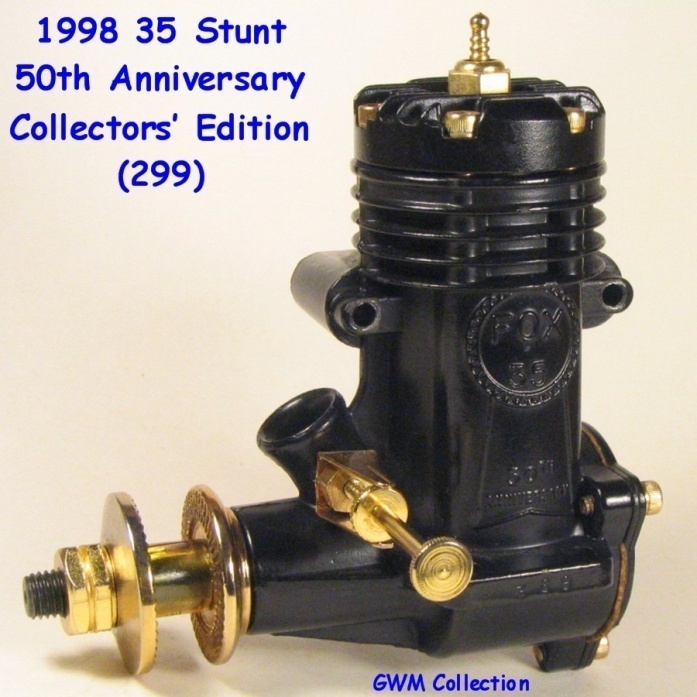|
FOX
MODEL MOTORS |
FOX
35 U/C
History
History

|
FOX
35 U/C
History |
 |
|
5-30-2020
|
||||||||

The history of the 35 Stunt Line below as written by Bill Morbacher
 |
One of the most famous model airplane engines ever made, the Fox 35 Stunt originated in 1948 (4). Universally called “Sandcast” engines, the first 35's were actually cast in ferrous permanent molds. The first 35 was made by Fox Engineering Labs (Duke Fox’s garage). It had as-cast cylinder fins, head bolt bosses between the top 2 cylinder fins, 4 bolt head, 2 bolt rear cover, and no web between the venturi and the cylinder. A universal Austincraft NVA was used.
|
 |
Fox teamed up with Dale Arnold and in 1949 the Arnold & Fox .35 (6) was introduced. Much like its predecessor except the cylinder fins were turned, a web was added between the venturi and cylinder, and the head bolt bosses were eliminated. |
 |
The .35, .800 x .700 B/S, was very successful and in late 1949 – 1950 a 29 was marketed. This was a .35 with a .smaller bore, 738 x .700 B/S. A 29 Racing Special was sold in 1950 (8) that was a 29 with handwork of the crankshaft, case, liner porting, and a meehanite crankshaft bushing. Externally, the engine has “29R” stamped on the front of the exhaust stack. |
 |
The 1951 35 Stunt (13) was the last "sandcast" 35, identical to the earlier engines except for the new 3 bolt rear cover. |
 |
Changes kept coming. In 1952, Fox changed to a diecast crankcase, six bolt diecast head, and diecast rear cover. The first engines used the A/C universal NVAs, but then used the new Fox designed NVA with the tapered flat on the NV and the brass clip. A .29 version was also sold (15). Up to now, the stunt engines used a taper drive thrust washer. O&R had a splined design and Fox contracted to use this thrust washer on the 1953 Stunt 35 (20) and 29. |
 |
In 1954 the O&R thrust washer was replaced with a thin blackened steel Fox design. The bypass was deepened, now flush with the lower cooling fin and the font on the “35” was changed. |
 |
Also, the 2 NVA venturi 2 speed design was offered (27) by slipping a turned aluminum secondary venturi with its own NVA into the existing venturi, retained by the lower NVA. |
 |
Another major case change came in 1958. Stiffening bosses were added between the cylinder fins. A thick black prop nut and thrust washer were introduced. And, as since 1950, a 29 version was still sold (47) although this was the last 29 Stunt. Interestingly, the 29 and 35 weren’t advertised as “Stunt” engines until this year. |
 |
Changes and “improvements” continued through the years. In the 1970s noise was becoming a concern and most manufacturers, including Fox began to offer mufflers and mounting provisions for them. The 1972 35 Stunt (120) was Fox’s first design for a muffler with tapped mounting bosses cast above and below the exhaust stack. This wasn’t a good design. Allen bolts held the muffler to the exhaust. Surfaces on the muffler and stack were as cast so a tight fit was impossible. The muffler body was higher than the bolt heads, so specially bent hex keys had to be used to turn the bolts, changing the wrench 3 times per revolution! |
 |
Fox did start to face off the stack, but a better attempt was made on the 1975 35 (143) by using a muffler that enveloped the end of the stack retained by long bolts that went through horizontal “ears” cast at the base of the stack. For a while, the tapped vertical bosses were retained so an old style muffler could be used on a new engine or visa versa. These horizontal ears were very fragile and could be damaged or cracked off by over-tightening or surely in a crash. |
 |
The real fix came about on the 1998 35 Stunt (298) when heavy extensions were cast onto the front and rear of the stack. Also, a hex head replaced the round head on the spraybar, so after 50 years, one could hold the spraybar from rotating and keep the fuel outlet holes positioned when tightening the retaining nut. This is the 35 Stunt still in production. |
 |
A Collectors’ Edition was produced in 1998 (299) that had a black finished case, head, rear cover, gold plated steel parts, serial number on the left lug, and a certificate of authenticity signed by Betty Fox. |
 |
The last Stunt 35 was the 2008 version (308). It had “60th Anniversary” in the ribbon on the bypass. The major change was the new Fox NVA. Fox quality was very good on these last engines. |
